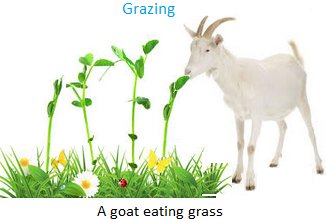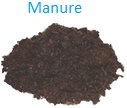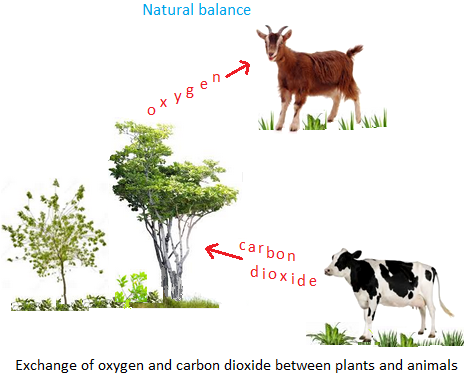Interdependence of Plants and Animals
We will discuss about the interdependence of plants and animals.
We are aware of the fact that human-beings depend upon plants and animals for food and other requisites of life.
Do plants and animals also depend upon each other?
Plants and animals also depend on each other. They do so in many ways.
Some of the following ways are:
(i) Some animals eat grass and green leaves of plants. They are called herbivorous.
Many animals also eat grains and other products of
plants.
Dung of animals, droppings of birds etc. are used to make manure. This manure helps to increase fertility of the soil and fertile soil helps the plant to grow better.
Thus, plants and animals help each other.
(ii) Flesh eating animals eat flesh of other animals, some of which depend on plants for food. Growth of the plants depends upon the manure coming from the animals droppings.
So animals depend upon plants and plants depend upon animals.
(iii) Human beings depend on both plants and animals for food. Human beings breathe in air containing oxygen. This oxygen is needful for our life. We breathe out carbon dioxide which mixes in the atmospheric air. Thus we take in oxygen from the air and give out carbon dioxide to it.
Like human beings all the animals (living things) adopt this process of taking in oxygen and giving out carbon dioxide.
So,
green plants take carbon dioxide from the air. This carbon dioxide is
used in preparing food for the plants by the process of photosynthesis.
During the process of photosynthesis oxygen is given out to the air.
Thus green plants take in carbon dioxide from the air and give out oxygen to it.
The oxygen thus released in air by the plants is taken in by animals who in return give out carbon dioxide to the air to be taken by the plants.
Thus a natural balance of oxygen and carbon dioxide in the atmosphere is maintained by plants and animals.
From Interdependence of Plants and Animals to HOME PAGE
Recent Articles
-
What Is Plasma? | Blood Plasma | Proteins | Nutrients | Cholesterol
Nov 07, 25 10:29 AM
Blood is a mobile fluid which is a connective tissue and is derived from the mesoderm like cell any other connective tissue. Colour of blood is reddish and that flows inside the blood vessels by means… -
Disorders of Respiratory System | Tuberculosis | Pleurisy | Emphysema
Oct 28, 25 11:39 PM
Tuberculosis is very common disease and is caused by a type of bacteria called Mycobacterium tuberculosis. This disease causes different trouble in the respiration and infection of several parts of th… -
Regulation of Respiration | Respiratory Centres | Inspiratory Area |
Oct 14, 25 12:13 AM
Respiratory Centre is the area that controls the rate of respiration and it is observed to be located in medulla oblongata and pons. Respiratory Centre has the following will dispersed components like… -
Explain Transport of Gases | External Respiration | Tissue Respiration
Oct 09, 25 11:35 PM
In humans gaseous exchange is completed in the following ways the steps are - External Respiration or Breathing - Breathing in false taking in of Oxygen and giving out of carbon dioxide in the body. M… -
Kind and Number of Teeth | Location of Teeth in Mouth | Care of Teeth
Sep 11, 25 12:52 AM
Kind and Number of Teeth








New! Comments
Have your say about what you just read! Leave me a comment in the box below.